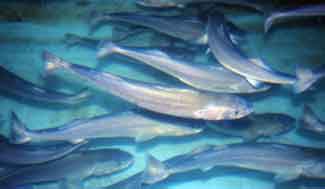

FBE Focal Species - Sablefish
 Sablefish (Anoplopoma fimbria) range from Japan north into the Bering Sea and south through Alaska and British Columbia to Mexico, with highest concentrations in Alaska. Adult sablefish, growing to 100 cm or more, live primarily in water deeper than 200 m and have been found as deep as 3000 m. Sablefish represent a highly valuable commercial species in the North Pacific Ocean, particularly in the Gulf of Alaska where the primary method of fishing is longline with limited amounts of trawling. Fishing for this species accelerated rapidly in the late 1960’s. Sablefish bring a high price per pound, like Pacific halibut, but much of the catch is exported to Asia. Current value in the US fishery is approximately $50 million per year. Because the adults live in deep water, there is virtually no sport fishery for sablefish. Sablefish (Anoplopoma fimbria) range from Japan north into the Bering Sea and south through Alaska and British Columbia to Mexico, with highest concentrations in Alaska. Adult sablefish, growing to 100 cm or more, live primarily in water deeper than 200 m and have been found as deep as 3000 m. Sablefish represent a highly valuable commercial species in the North Pacific Ocean, particularly in the Gulf of Alaska where the primary method of fishing is longline with limited amounts of trawling. Fishing for this species accelerated rapidly in the late 1960’s. Sablefish bring a high price per pound, like Pacific halibut, but much of the catch is exported to Asia. Current value in the US fishery is approximately $50 million per year. Because the adults live in deep water, there is virtually no sport fishery for sablefish.
Spawning by sablefish occurs in deep water (300-700 m) along the continental slope, with exact depth and season depending upon location. In Alaska, maximum spawning occurs in March through April, while between California and British Columbia spawning occurs earlier, from January to March. Eggs and larvae are collected primarily in deep water, but young-of-the-year (<8 cm) are found in near-surface waters and can be collected in neuston nets at night on the continental shelf during late spring off Oregon. The smallest individuals eat zooplankton in their first weeks of life. The juveniles grow rapidly, move to deeper water and become piscivorous with size.
See the AFSC pages on Sablefish Research for more information about current sablefish research and fishing activities in Alaska, including survey reports and tag-recovery efforts.
Focal Species Links:
Last updated
14 March, 2007
FBE Webmaster
|

 Sablefish (Anoplopoma fimbria) range from Japan north into the Bering Sea and south through Alaska and British Columbia to Mexico, with highest concentrations in Alaska. Adult sablefish, growing to 100 cm or more, live primarily in water deeper than 200 m and have been found as deep as 3000 m. Sablefish represent a highly valuable commercial species in the North Pacific Ocean, particularly in the Gulf of Alaska where the primary method of fishing is longline with limited amounts of trawling. Fishing for this species accelerated rapidly in the late 1960’s. Sablefish bring a high price per pound, like Pacific halibut, but much of the catch is exported to Asia. Current value in the US fishery is approximately $50 million per year. Because the adults live in deep water, there is virtually no sport fishery for sablefish.
Sablefish (Anoplopoma fimbria) range from Japan north into the Bering Sea and south through Alaska and British Columbia to Mexico, with highest concentrations in Alaska. Adult sablefish, growing to 100 cm or more, live primarily in water deeper than 200 m and have been found as deep as 3000 m. Sablefish represent a highly valuable commercial species in the North Pacific Ocean, particularly in the Gulf of Alaska where the primary method of fishing is longline with limited amounts of trawling. Fishing for this species accelerated rapidly in the late 1960’s. Sablefish bring a high price per pound, like Pacific halibut, but much of the catch is exported to Asia. Current value in the US fishery is approximately $50 million per year. Because the adults live in deep water, there is virtually no sport fishery for sablefish.